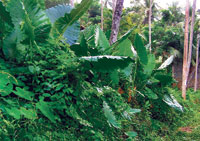Have you noticed that habarala (Alocasia macrorhiza) plants are growing wild in our wet zone? The spread of habarala, an invasive plant, is out of hand.
Weed experts in Sri Lanka have included this plant under the “invasive” category and it is the responsibility of the public to manage this plant.
Originating in the South East Asian region, the rampant spread of habarala in Sri Lanka may be attributed to the fact that it is commonly cultivated as a garden or indoor plant.
Its main propagation methods are by planting seeds or stems, with the adult plant growing to a height of about two-three metres.
Vast stretches of habarala can be seen in plantations, on vacant land and also natural environments. Meanwhile, recent observations indicate that the long-leafed stalk of habarala provides an ideal breeding place for dengue mosquitoes.
All right-thinking people should consider the country’s biodiversity, what harm invasive plants could cause and get rid of the menace of habarala from their gardens.
|

